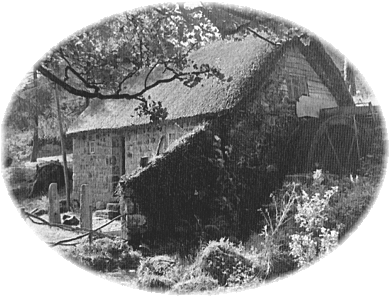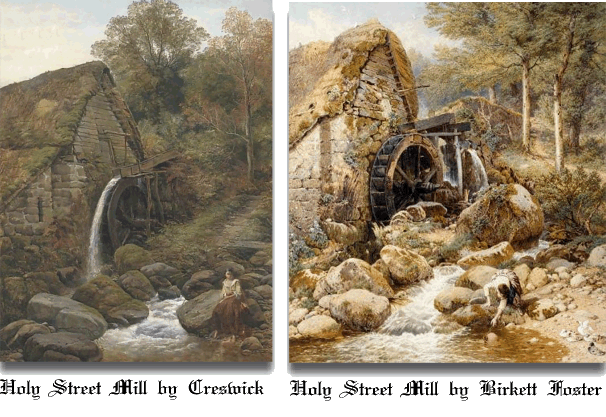
“None will be allowed to remain long in the town (Chagford) without hearing of Holy Street Mill – the Grist Mill’ as it is commonly called – an old thatched watermill by the Teign, beloved by artists for generations.”
J. Ll. W. Page, 1898, p.179.
As Mr. Page notes above the old Holy Street Mill at Chagford has indeed drawn the attention of many artists and postcard photographers over the years. In all reality there was not a lot going for the actual mill apart from its idyllic setting which provided a much sought-after pastoral scene for the early seekers of the ‘picturesque’. When you look at the works of the artists and photographers they all seem to capture that vision of long lost rustic England of yesteryear. Amongst the landscape artists who painted the mill was Myles Birkett Foster, George Burrell Willcock, William Williams, William Spreat and William Widgery to name but a few. Some of these works were exhibited at the Royal Academy. The attraction of the Holy Street Mill was summed up by an anonymous artist’s impression of the place in 1882; “Presently I and my companion heard a water-mill at work. An old thatched building with an over-shot water wheel is always picturesque but when that mill is set round with golden birch-trees and rough rocks and tumbling water to constitute the foreground, you do not need to go much further for a subject.” p.247.
Holy Street Mill was a particular favourite of the prolific photographer Francis Frith who took numerous pictures of the place some of which were used as early postcards. Incidentally the popularity of some of these pictures lives on as today as it is possible to buy a cross-stitch reproduction kit of the mill.
Writing in 1848 Samuel Rowe prosaically describes the mill thus: “The mill at Holy Street – the substantial dwelling-house hard by with high pitched roof and gables, mullioned windows and low-browed doorways, all of enduring moorstone, its quaint terraced garden, trim with ever-green hedges, its enclosed paved court, with a crystal streamlet running through it to join the river below – all suggestive of old hereditary occupancy and rural quiet – and all felicitously harmonizing with the sequestered and sylvan character of the surrounding scenery.”, p.113.

Some 60 years later Beatrix Creswell wrote the following the The Homeland Guide to Dartmoor: “For our first walk we will stroll down to the site of Holy Street Mill, so well known pictorially. Time was when an Academy Exhibition was never opened without at least one picture of Holy Street Mill. It has now totally disappeared and the pictures alone preserve its traditional beauty.”, p.48.
Firstly, let’s look at the location of the old mill – Holy Street, initially the place-name would suggest some religious connotation. Indeed if you look at the early map below you will see that just south of the mill there was a stone cross which could have connotations. Alternatively there is a rather misguided suggestion that at one time: “a sacred Druidical road once passed this way from the cromlech at Shilston to the circle on Scorhill Down.”, Murray, p.127. As the Druids could be classed as Pagans I can’t see how anything associated with them could be considered ‘holy’.
However neither of the above are the case and the actual topography of the landscape hints at the root of the place-name. In the Assize Rolls of 1219 the manor is listed as Holesterte and Gover et. al. suggest that the name derives from two old Anglo Saxon words holh and steort, p.425. Holh translates as a hollow, Clark Hall, p.189, and steort as a spit of land, Clark Hall, p.321. This then gives Holesterte a meaning of a ‘spit of land in the hollow’ and over the centuries Holesterte has mutated to Holy Street. But what an appropriate name for both the manor and mill are located in a bulbous tract of land around which the river Teign curves.

So having discovered why it’s called Holy Street Mill what about the place itself? There was a suggestion that the mill was first built in the 11th century and belonged to the nearby manor of Teigncombe, Hayter-Hames, p.19, however today the origins of the present building are assumed to date to seventeenth century or possibly a bit earlier. The mill was powered by an overshot waterwheel which can be seen in all of the pictures below. There is some speculation that at one time there were possibly two waterwheels associated with the mill. This theory stems from the fact that a lithograph ‘by and after’ William Spreat dating to 1844 shows a wheel on the left gable side of the mill. Additionally another watercolour painting by Charles Frederick Williams also shows a wheel on the same opposite side. Bodman, pp. 65 – 66. Whether these were a case of artistic licence is unknown. The water used to drive the wheel was taken from a small leat that ran off the river Teign to the west of the mill, this then gently contoured around for about 300 metres to meet the mill’s wheel by means of a wooden launder.
Some time in the early 1900s the mill fell into disuse and it is thought that in 1906 it finally closed down. Gradually over time the building fell into ruins as can be seen from the last photograph below. Rice, p.40.

The demise of the mill is not the end of this story for phoenix-like the structure rose from the ruins to perform another function. Around 1890 a man called Mr. Reed took over two of the old woollen mills which were located to the east of Holy Street. These were used to crush oats and also acted as sawmills, nothing revolutionary there. But what was unique was the power source – electricity, Reed harnessed the power of the river Teign to drive, by means of an overshot waterwheel, an hydroelectricity plant. So efficient was this that in time the electricity was used to power street and household lighting to the town of Chagford. Barber, 1994. p.9. As Holy Street was also ideally located near to such a water supply it too began generating its own electricity supply. Bodman notes how sometime in the early 1900s an overshot waterwheel measuring 12 foot by 3 foot was installed at Holy Street and by the 1920s it was producing electricity for the mill house.. Today the mill still produces that same electricity supply but by means of a new crossflow turbine that was installed in 2011. p.66.
Why is there no up-to-date picture or photograph of Holy Street Mill you may ask? Well in a sentimental way I like to think of the old mill in all its days of rustic glory not just an empty shell hinting at what once was. All those artists and photographers saw the ‘picturesque’ in this tiny corner of Dartmoor and that is how it should be remembered. Just maybe their work can fire a spark of imagination as to what that pastoral scene would have been way back in those halcyon days.

Bodman, M. 2015. Mills on the Teign. Cullompton: Leat Press.
Barber, C. 1994. The Great Little Chagford Book. Exeter: Obelisk Publications.
Clark Hall, J. R. 2004. A Concise Anglo-Saxon Dictionary. London: Cambridge University Press.
Cresswell, B. 1912? The Homeland Guide to Dartmoor – No. 8. London: The Homeland Association Ltd.
Gover, J. E. B., Mawer, A. and Stenton, F. M. 1998. The Place-Names of Devon. Nottingham: English Place-Name Society.
Hayter-Hames, J. 1981. A History of Chagford. London: Phillimore & Co. Ltd.
Murray, J. 1865. A Handbook for Travellers in Devon & Cornwall. London: John Murray.
Page, J. Ll. W. 1898. An Exploration of Dartmoor. London: Seeley & Co.
Rice, I. 2002. The Book Of Chagford. Tiverton: Halsgrove.
Rowe, S. 1985. A Perambulation of Dartmoor. Exeter: Devon Books.
 Legendary Dartmoor The many aspects past and present of Dartmoor
Legendary Dartmoor The many aspects past and present of Dartmoor

Hi,
I stayed in the house as a holiday let about 1974 and was facinated by the mill. The wheel was present but decayed with a chain to drive the generator. There was also a turbine driving another generator. A set of lead acid batteries had been present with the odd glass container remaining. I worked out the voltage by counting the number of accumulators, 50 or 100 volts. I would guess the turbine dated from the 1950’s. I may have photos.
The milll features in ‘Windmills & Watermills from old Photographs’ which has a picture dated 1856
I’m still interested in mills & belong to the Sussex Mills Society.
During the 1950s a school, naming itself St Brides, was set up by two ladies, which took in day and boarding pupils. My sister and I both boarded for a short time at this school.